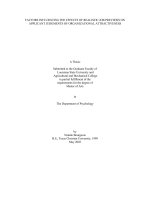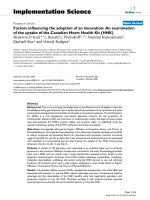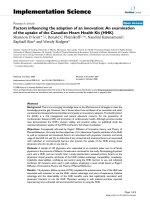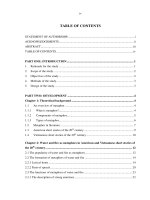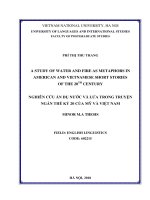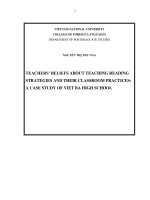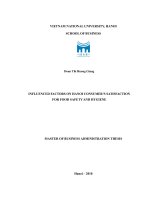FACTORS INFLUENCING PERCEIVED SELFEFFICACY OF VIETNAMESE PRE SERVICE EFL TEACHERS = các NHÂN tố ẢNH HƯỞNG đến sự tự TIN NĂNG lực của GIÁO SINH VIỆT NAM CHUYÊN NGÀNH GIẢNG dạy TIẾNG ANH
Bạn đang xem bản rút gọn của tài liệu. Xem và tải ngay bản đầy đủ của tài liệu tại đây (930.3 KB, 75 trang )
VIETNAM NATIONAL UNIVERSITY, HANOI
UNIVERSITY OF LANGUAGES AND INTERNATIONAL STUDIES
FACULTY OF ENGLISH LANGUAGE TEACHER EDUCATION
GRADUATION THESIS
FACTORS INFLUENCING PERCEIVED SELFEFFICACY OF
VIETNAMESE PRE-SERVICE EFL TEACHERS
Supervisor: Nguyen Thi Thinh, M.A
Student: Bui Thi Ngoc
Course: QH2017.F1.E6
HANOI - 2021
i
ĐẠI HỌC QUỐC GIA HÀ NỘI
TRƯỜNG ĐẠI HỌC NGOẠI NGỮ
KHOA SƯ PHẠM TIẾNG ANH
KHÓA LUẬN TỐT NGHIỆP
CÁC NHÂN TỐ ẢNH HƯỞNG ĐẾN SỰ TỰ TIN
NĂNG LỰC CỦA GIÁO SINH VIỆT NAM CHUYÊN
NGÀNH GIẢNG DẠY TIẾNG ANH
Giáo viên hướng dẫn: Th.S Nguyễn Thị Thịnh
Sinh viên: Bùi Thị Ngọc
Khóa: QH2017.F1.E6
HÀ NỘI - 2021
ii
ACKNOWLEDGEMENT
I am extending my profound thanks to the many people since the completion of my
Bachelor thesis paper could not have been possible but for their participation and
assistance.
First and foremost, I would like to express my sincere gratitude to my supervisor,
M.A Nguyễn Thị Thịnh, for her encouragement, appreciation, and providing me
with invaluable guidance throughout this research. Her immense knowledge and
constructive feedback helped my journey proceed much easier. She fostered me to
understand deeply the methodology to carry out the research and to present the
research works as clearly as possible. I suppose it was a great privilege and honor to
work and study under her supervisions.
My gratitude is also extented to all my classmates and senior students at University
of Languages and International Studies who participated in my study and willingly
contributed valuable information to my research. I would like to specially thank my
group of friends, Tạ Minh Loan, Nguyễn Linh Giang, Nhữ Thu Sang, who were also
proceeding with their thesis paper. Thanks to their encouragement, empathy and
advice, I could go for the research work to the end.
Finally, I would like to express my huge thanks to my parents for their love, prayers,
understanding and caring for educating and supporting me to complete this research.
With my family who are always beside me, I could be more confident in mastering
all my work and preparing for my future.
iii
TABLE OF CONTENTS
ACKNOWLEDGEMENT
iii
TABLE OF CONTENTS
iv
LIST OF FIGURES
vii
LIST OF TABLES
vii
ABBREVIATION
viii
ABSTRACT
ix
CHAPTER 1: INTRODUCTION
1
1. Rationale for the study
1
2. Research aims and objectives
3
3. Research questions
3
4. Significance of the study
3
5. Scope of the study
4
6. Organization of the paper
4
CHAPTER 2: LITERATURE REVIEW
5
2. Key concepts and theories
5
2.1. Conceptions of teacher self-efficacy theory
5
2.1.1. Bandura’s self-efficacy theory
5
2.1.2. Teacher self-efficacy
6
2.1.3. Sources of self-efficacy information in relation to teacher self-efficacy
7
2.1.4. Tschannen-Moran’s teacher self-efficacy and measurement of teacher selfefficacy
10
2.2. Studies on factors influencing teacher self-efficacy in EFL context
12
2.2.1. Studies on Bandura’s sources of self-efficacy information in relation to
perceived self-efficacy of EFL teachers
13
2.2.2. Studies on other prominent factors influencing perceived self-efficacy of
EFL teachers
15
2.2.3. Research gaps
16
CHAPTER 3: METHODOLOGY
18
iv
3.1. Research participants and context
18
3.2. Data collection instruments
19
3.3. Data collection
20
3.4. Data analysis instrument
21
3.5. Assessment of scale reliability
22
3.6. Ethical considerations
23
CHAPTER 4: RESULTS AND DISCUSSION
24
4.1. Results
24
4.1.1 The levels of pre-service EFL teachers’ sense of self-efficacy
24
4.1.2. Factors affecting the pre-service EFL teachers’ sense of self-efficacy
25
4.1.3. ELT education
26
4.1.4. Teaching recognition
28
4.1.5. Lack of teaching experience
31
4.1.6. English proficiency
32
4.1.7. Personal qualities
33
4.2. Discussion
33
4.2.1. Levels of pre-service EFL teachers
34
4.2.2. Factors influencing teaching self-efficacy of pre-service EFL teachers
34
4.2.3. Mastery experience
34
4.2.4. Social persuasion
37
4.2.5. Affective states
38
CHAPTER 5: CONCLUSION
40
5.1. Theoretical contribution
40
5.2. Pedagogical implications
40
5.3. Limitations and suggestions for further study
42
References
43
APPENDIX 1
56
APPENDIX 2
64
v
APPENDIX 3: PARTICIPANT CONSENT FORM
vi
65
LIST OF FIGURES
Figure 1: Model of the relationship among factors in Social Cognitive Theory
(Adapted from Bandura, 1997) ............................................................................ 5
Figure 2: Model of Teacher self-efficacy by Tschannen-Moran et al. (1998) .... 11
LIST OF TABLES
Table 1: Examples of forms of Sources of teacher self-efficacy information in
the literature (Phan, 2015b) .................................................................................. 8
Table 2: Subscales Cronbach’s alpha reliabilities (α) ........................................ 20
Table 3: Number of distributed and returned questionnaires ............................. 22
Table 4: Levels of LTSE in different subscales and total LTSE ........................ 24
vii
ABBREVIATION
English as a foreign language: EFL
English language teaching: ELT
Language Teacher Self-efficacy:
LTSE
Pre-service teachers: PSTs
Social cognitive theory: SCT
Teacher self-efficacy: TSE
viii
ABSTRACT
Teacher self-efficacy is considered as one of the most important factors contributing
to success or failure in teachers’ teaching performance. Among domain-specific
branches of teachers’ self-fefficacy (TSE) beliefs, language teachers’ self-efficacy
(LTSE) has been paid inadequate attention despite its significance to study in
education. This study, thus, investigated levels of LTSE of pre-service EFL teachers
and explored factors influencing the self-efficacy in teaching English as a Foreign
Language (EFL) of preservice EFL teachers. The study used a mixed method design
in order to collect data information from 114 seniors majoring in EFL teaching at a
state university in Vietnam. The quantitative method revealed a moderate level of
overall LTSE perceived by PSTs, with the highest rating being Instructional
Strategies while the lowest level being Student Engagement. The data analysed from
group focus interview pointed out social persuasion was the most influential source
of self-efficacy information. The findings also indicated generally how different
sources of self-efficacy information interacted with another one. Contributions and
implications were then suggested according to the findings.
ix
CHAPTER 1: INTRODUCTION
This chapter generalizes the rationale for the research, and clarifies the research
aims, research questions, significance of the study, scope of the study, and provides
the organization of the thesis paper. It is then utilised as a research foundation for
other chapters.
1. Rationale for the study
It is universally noted that teachers make a crucial contribution to the development
and maintenance of an intelligent, informant citizenry (The Ministerial Council on
Education, Employment, Training and Youth Affairs [MCEETYA], 1999). Teachers
play some crucial and molding roles in terms of realizing specified aims and
objectives of the system and promoting student achievements (Demirtaş, Cưmert, &
Ưzer, 2011).
By virtue of the teacher’s importance, research exploring underlying factors that may
have an impact on teachers and their profession has been received much attention in
the literature. In academic literature, teacher self-efficacy (TSE) that is defined as
“the teacher’s belief in his or her capability to organize and execute courses of action
required to successfully accomplish a specific teaching task in a particular context”
(Tschannen-Moran, Hoy, & Hoy, 2001), has been attractted widespread interested
from ucational researchers due to its relations to teaching effectiveness (Armor et
al., 1976; Berman and MC Laughlin, 1977; Brookover et al., 1978, as cited in Gibson
& Dembo, 1984). For example, high-efficacy teachers are argued to be often
allocate more class time for academic activities and less time for nonacademic ones
(Gibson & Dembo, 1984), which might allow them to yield more academic
achievements. Teachers with a strong sense of self-efficacy are more willing to take
greater responsibility for students who are having difficulties, search and apply
various teaching materials and activities appropriately, produce better performance,
and probably remain occupational commitment (Klassen, Tze, Betts, & Gordon,
2011; Tschannen-Moran et al., 1998). In contrast, low-efficacy teachers have a
tendency to avoid challenging tasks, for example, they are likely to invest slight
1
efforts to or give up tasks when it comes to teaching struggling students as those
individuals often believe that they may not cope with such tasks (Bandura, 1997).
In English language teaching (ELT), TSE appears to be of great importance to
understanding beliefs or confidence of ELT teachers who are non-native speakers as
they are related to “teacher effectiveness and appears to influence students’
achievement, attitude, and affective growth” (Oh, 2011) and regarded as “the major
predictors of teachers’ competence and commitment to teaching” (Silverman &
Davis, 2009). However, there is a moderate number of studies on self-efficacy in
EFL or ESL settings. Despite pior researchers’ attempts, Klassen et al. (2011) argued
that it lacks recognition of research on TSE in ESL/EFL teaching contexts within
the self-efficacy research literature.
Considering Vietnamese context, although the National Foreign Language Project
in the 2008-2020 period was launched, the quality of teaching and learning English
is reported ineffective (Nguyen, 2019, as cited in Phan, 2015b). Moreover, it is
reported that dedication to teaching career after graduation holds little attraction for
many PSTs. According to Vietnam’s Ministry of Finance (MOF, 2017 as cited in
Nguyen, 2017), many graduates of the Teacher Education program choose to follow
other careers other than teaching. Considering English language teachers, collected
statistics shows a shortage of more than 5,600 English language teachers from
different educational strands (MOET, 2018; as cited in Nguyen, 2018). Several
studies, thus, have been carried out for the sake of understanding teachers’
motivation and proposing solutions for better teaching and learning English (Phan,
2009; Phan & Phan, 2010; Tran, 2007). However, few of them provided deficient
understanding of affecting factors regarding pre-service EFL teachers’ beliefs in
their capability to teach English (Hoang & Wyatt, 2020). The researcher of the
current study, therefore, made a decision on a study exploring EFL teachers’ selfefficacy and factors that may affect it in the Vietnamese context. Moreover, given
the important attribute of a strong sense of efficacy for optimal motivation in
teaching, identifying factors that contribute to the initial development of PSTs’
efficacy will enable them to develop strong efficacy beliefs early in their career. It
2
was expected that the study might make a contribution to further research in the
concept of teacher self-efficacy and support educators and policy makers in Vietnam
with a view to improving teacher training programs in which TSE of EFL teachers
is noted, enhancing the quality of English teaching and learning in the future.
2. Research aims and objectives
The aim of this study is to investigate levels of TSE of Vietnamese pre-service EFL
teachers and understand factors influencing TSE of Vietnamese pre-service EFL
teachers. To achieve this aim, the research addressed three following objectives:
To examine the level of the self-efficacy of pre-service EFL teachers.
To determine factors influencing perceived self-efficacy of pre-service EFL
teachers.
To examine how factors influence perceived self-efficacy of pre-service EFL
teachers.
3. Research questions
In order to tackle the objectives, two main questions were established:
1. What are the levels of pre-service EFL teachers’ sense of self-efficacy, as
perceived by pre-service EFL teachers?
2. What are the factors affecting the pre-service EFL teachers’ sense of selfefficacy, as perceived by pre-service EFL teachers?
4. Significance of the study
Acknowledging the significance of understanding of pre-service EFL teachers’
selfefficacy beliefs, the research was carried out with a belief in helping them
develop strong efficacy beliefs early when they are in their training years, serving
the future career path. Findings of the study, therefore, suggested for both theoretical
contributions and pedagogical implications. Regarding pedagogical implications,
findings of the current study are expected to help educators gain a deeper
understanding of the quality of EFL future teachers and factors influencing their
efficacy perceptions, whereby fostering educators and policy makers to make a case
for concrete change of teacher training programs at Vietnamese institutions.
Additionally, theoretical contributions offer a deeper insight in theories related to
3
teacher self-efficacy beliefs, especially TSE in EFL settings, creating a basis for
further research
5. Scope of the study
The study was conducted at a foreign language institution in Vietnam with
participation of 114 senior students majoring in English language teacher education.
The current study figured out levels of pre-service EFL teachers’ self-efficacy and
factors influencing self-efficacy of pre-service EFL Vietnamese teachers.
6. Organization of the paper
This paper is organized as follows:
Chapter 1. Introduction: This chapter gives a brief overview of the rationale for
the study, research aims, research questions, the significance of the study, and the
scope of the study.
Chapter 2. Literature review: This chapter discusses the literature that is relevant
to the current study. The research gaps are identified in this chapter to create a
foundation for further discussions.
Chapter 3. Methodology: This chapter details how the study is conducted by
explaining the participants, methods, data collection procedure, and data analysis
procedure of the study.
Chapter 4. Results and discussions: This chapter describes results of the study
according to two main research questions and then discusses the findings to gain a
deeper insight.
Chapter 5. Conclusion: This chapter provides a synthesis of major findings,
theoretical contributions and several possible implications as well as suggestions for
further research.
4
CHAPTER 2: LITERATURE REVIEW
This chapter elaborates theoretical key concepts and prior studies relating to the
research, namely Bandura’s self-efficacy theory, teacher self-efficacy, studies on
factors influencing teacher self-efficacy. It is then utilised to verify the research gaps,
creating a research foundation for other chapters.
2. Key concepts and theories
2.1. Conceptions of teacher self-efficacy theory
2.1.1. Bandura’s self-efficacy theory
Self-efficacy theory is the core concept constructed in Bandura's (1977, 1986, 1997)
social cognitive theory (SCT) with the assumptions that people’s actions are attached
to their intents. SCT postulated the idea that environmental factors, personal factors
and behaviors are impacting on one another bi-directionally (Bandura, 1997). For
instance, teachers may perceive that their teaching (behavior) is negatively affected
by a lack of students’ focus (environmental factors). Simultaneously, a lack of
confidence in their teaching ability (personal factor) can be caused by teachers’
perceptions of ineffective teaching performance (behavior).
Figure 1: Model of the relationship among factors in Social Cognitive Theory
(Adapted from Bandura, 1997)
Personal factors (e.g.
thoughts, emotions,
beliefs-self-efficacy
beliefs)
external environment
(social supports/barriers)
Behavioural factors
The relationship among the three factors of SCT is “reciprocally deterministic” but
the impact of each factor on the subject varies and depends on individuals and
5
specific situations (Bandura, 1997). Self-efficacy theory developed from SCT,
accordingly, refers a concept of one’s beliefs from a domain– and task-specific
angle. According to Bandura (1997), self-efficacy demonstrates “belief in one’s
capabilities to organize and execute the courses of action required to produce given
attainments”. In other words, “self-efficacy is a person’s belief in his/her ability to
succeed in a particular situation” (Garrido et al., 2020). Perceived self-efficacy, thus,
plays a role as a preditor of how people pursue challenging tasks, commit, encounter
and accomplish tasks and mediating their behaviors. Self-efficacy theory has been
intensively researched within many different disciplines from medicine (Chen et al.,
2010), psychology (Maddux & Stanley, 1986; Bandura, 1989) to economy (Latham
& Brown, 2006), military (Britt et al., 2004) and education (Tschannen-Moran &
Woolfolk Hoy, 2001).
2.1.2. Teacher self-efficacy
Within educational research, a specific self-efficacy domain which has been an
appealing subject to researchers’ and practitioner’s attention is entitled teacher selfefficacy (TSE). Teacher self-efficacy is noted as “a cognitive process in which
teachers construct their beliefs about their capacity to perform at a given level of
attainment” (Tschannen-Moran et al., 1998). According to Yeung & Watkins
(2000), teachers’ beliefs influence “the way they learn to teach, and their
perceptions, judgments, decision-making and actions in the classroom”. TschannenMoran and Hoy’s (2001) literature review suggested that teacher self-efficacy is
considered as an influential factor in predicting whether teachers accomplish their
teaching tasks or not and their behaviors towards their career. TSE has been received
much attraction from educational researchers. Particularly, the research into TSE is
regarded as “stand on the verge of maturity” in maths and science teaching
(Tschannen-Moran et al., 1998). However, aspects of this concept are not welldocumented within the self-efficacy research literature of teaching English as a
second/foreign language (Klassen et al., 2011). The reason argued by Faez and Karas
(2017) is since English language plays a unique role in the research field itself in
both the content and the means of instruction.
6
2.1.3. Sources of self-efficacy information in relation to teacher self-efficacy
Based on Bandura’s (1997) proposition, there are four sources constructing selfefficacy beliefs: mastery experiences, vicarious experiences, verbal persuasion, and
physiological and affective states. A mastery experience indicates one’s perceptions
of his/her past successful performance of the task. Vicarious experience refers to
one’s action via observing of and learning from a model performance of the task.
Verbal persuasion includes social impacts such as feedback, support, interaction
concerning one’s capabilities. The physiological/affective states relate to factors
influencing emotion, thoughts, mental health, and so on.
Since self-efficacy beliefs and teacher self-efficacy are constructs established
according to domain-specific and context-specific, its development might be
affected by certain factors. In the integrated model of the teacher self-efficacy
construct struck out by Tschannen-Moran et al. (1998), these four sources of selfefficacy information also play a key role by contributing information to task analysis
and assessment of personal teaching competence. Specifically, mastery experiences
covers teachers’ perceptions about the quality of their teaching practice (e.g.
teaching knowledge content, teaching skills and strategies); vicarious experiences
mention their own thoughts of their capabilities or skills when compared to other
teachers or of their workplace environment (e.g. hearing/modeling others’ teaching,
…); verbal/social persuasion delves into the effect of verbal/ non-verbal judgement
and recognition from students or supervisors (including feedback, compliments,
behaviors from others …); and physiological/emotional states present feelings the
teachers generate or adjust in the teaching process such as happiness, satisfaction,
confidence, or pressure (Oh, 2010; Tschannen-Moran & Woolfolk Hoy, 2007, as
cited in Sevimel & Subasi, 2018). Among those sources, mastery experience is
mostly suggested as the most powerful one that influences the formation of selfefficacy beliefs (Bandura, 1997).
7
Table 1: Examples of forms of Sources of teacher self-efficacy information in the
literature (Phan, 2015b)
Sources
Forms
Mastery
experiences
Student
successful
performance
and
achievement
(e.g.TschannenMoran and McMaster, 2009; Morris and Usher, 2011;
Milner, 2002)
Past teaching performances (e.g.Tschannen-Moran and McMaster,
2009; Morris and Usher, 2011; Poulou, 2007)
Mastery of content and skills (e.g. Palmer, 2006; Palmer, 2011;
Morris and Usher, 2011; Lee, 2009; Chacon; 2005)
Mastery of English language (e.g. Lee, 2009; Chacon; 2005)
8
Social
persuasion
Social persuasion Praise, encouragement, teaching award (e.g.
Morris & Usher, 2011; Zeldin and Pajares; 2000; Palmer, 2011)
Support (e.g. Capa and Woolfolk Hoy, 2005; Tschannen-Moran &
Woolfolk Hoy, 2007)
Respect (e.g. Cheung, 2008; Milner, 2002; Milner & Hoy, 2003)
Enthusiasm (Mulholland & Wallace, 2001; Poulou, 2007) Norms of
neglect (e.g. Milner & Hoy, 2003)
Criticisms (e.g. Milner, 2002)
Negative feedbacks (e.g. Capa and Woolfolk Hoy, 2005)
Lack of feedbacks (Mills, 2011)
Social isolation, stereotype threat, non-responsiveness (e.g. Milner
& Hoy, 2003)
Workshops and development courses (e.g. Tschannen-Moran &
McMaster, 2009; Tschannen-Moran & Johnson, 2011; Palmer, 2011)
Coaching and mentoring (e.g. Tschannen-Moran & McMaster,
2009; Ross & Bruce, 2007)
9
Vicarious
experiences
Seeing/observing others teach (e.g. Zeldin and Pajares, 2000; Capa
and Woolfolk Hoy, 2005; Palmer, 2011; Mills, 2011)
Imagining others teach (e.g. Capa and Woolfolk Hoy, 2005; Ross &
Bruce, 2007)
Hearing about others teach (e.g. Mulholland & Wallace, 2001; Ross
& Bruce, 2007)
Self-modeling (e.g. Palmer, 2006; Ross & Bruce, 2007; Johnson,
2010)
Psychological/
Affective
states
Anxiety, stress (e.g. Ross & Bruce, 2007; Milner & Hoy, 2003;
Palmer, 2006)
Depression (Kim & Kim, 2010)
Fear, doubt, pressure (e.g. Milner & Hoy, 2003; Poulou, 2007; Watt,
2013; Palmer, 2006; Milner, 2002)
Tiredness, exhaustion, fatigue (e.g. Poulou, 2007: Morris & Usher,
2011)
Sleep loss, constant worry, uncertainty (e.g. Watt, 2013).
Happy, excitement (e.g. Morris & Usher, 2011; Mills, 2011)
2.1.4. Tschannen-Moran’s teacher self-efficacy and measurement of teacher
self-efficacy
In undertaking teacher self-efficacy as context-specific, Tschannen-Moran and
colleagues (1998) also contributed to expanding Bandura’s (1997) self-efficacy
theory in accordance with teaching context. As for their theory, they defined teacher
10
self-efficacy as “the teacher’s belief in his or her capability to organize and execute
courses of action required to successfully accomplish a specific teaching task in a
particular context” (Tschannen-Moran et al., 1998). This stance of TSE is more valid
when a specific scale for measuring levels of TSE was introduced. The Teacher's
Sense of Efficacy Scale (TSES) launched by Tschannen-Moran and Woolfolk Hoy
(2001) offers three dimensions of TSE embracing instructional strategies, classroom
management, and student engagement.
Figure 2: Model of Teacher self-efficacy by Tschannen-Moran et al. (1998)
Accordingly, the researchers conceptualized teachers' self-efficacy clearly,
including beliefs about their capabilities to teach, to discipline classroom behavior,
and to motivate students learning. To be more specific, self-efficacy regarding
instructional strategies presents teachers' beliefs about their ability to use various
teaching strategies effectively, whereas self-efficacy concerning classroom
management refers to beliefs about one's ability to regulate students' behavior
during class. In contrast, self-efficacy with regard to student engagement reflects
teachers' beliefs whether they can foster students’ motivation and enthusiasm in the
learning process. Tschannen-Moran et al., (1998) argued that their conceptualization
of teacher self-efficacy contributes to a fuller understanding of the construct of
teacher self-efficacy beliefs. The scale has been labeled ‘‘superior to previous
measures of teacher efficacy’’ due to its close alignment with self-efficacy theory
(Woolfolk Hoy & Burke Spero, 2005).
11
However, researchers using adapted versions of Tschannen-Moran and Woolfolk
Hoy’s (2001) instrument with L2 teachers often neglected a fact that this instrument
may not be applicable to elicit self-efficacy beliefs regarding several specificcontext tasks as the EFL context, for instance, English grammar in Turkey (Wyatt
& Dikilitaş, 2019) and high school ELT in Japan (Thompson, 2020). Cultural issues
with regard to mainstream education in Asia are mentioned as reasons leading to
differences in using Tschannen-Moran and Woolfolk Hoy’s (2001). For example,
Cheung (2008) and Tsui and Kennedy (2009) both asserted that dimensions of
student engagement and instructional strategies loading on the same factor when
applied in Asian contexts. This integration, according to Hoang and Wyatt (2020)
“may reflect a “generic cultural concern in Confucian heritage society”, where
teachers are expected to engage their students both inside and outside the
classroom”. The second factor that these researchers identified included items
related to managing students’ misbehaviours, which seems to reflect the influence
of Confucian values demanding teachers show power and control over their students
(Cheung, 2008). Due to existing differences, factor analysis for EFL context based
on consultation with local teaching experts is particularly necessary with aims of
creating a scale measuring self-efficacy of language teachers and ensuring task- and
domain-specific.
2.2. Studies on factors influencing teacher self-efficacy in EFL context
In recent years, English is regarded as the most important international foreign
language, and thereby research of teacher self-efficacy beliefs both in general and in
domain contexts has been favoured by educational researchers and policy makers.
Major subject matters discussed in such studies have surrounded the relationship
between TSE and related-variables such as burnout/job stress (e.g. Klassen & Chiu,
2010; Vaezi & Fallah, 2011), job satisfaction and occupational commitment (e.g.
Klassen & Chiu, 2010), students’ achievement (e.g. Saeidi & Kalantarypour, 2011),
teacher knowledge (e.g. Zakeri & Alavi, 2011), teaching styles (e.g. Heidari,
Nourmohammadi & Nowrouzi, 2012), motivation (e.g. Huangfu, 2012; Billim,
2014), micro-teaching (e.g. Arsal 2014; Clinici, 2016), English language proficiency
12
(e.g. Chacon, 2005; Eslami & Fatahi, 2008; Ghasemboland & Hashim, 2013;
Jafarigohar & Ganjabi, 2012; Lee, 2009; Lee and Choi, 2016; Hoang and Wyatt,
2020) and attitudes towards English language (e.g. Mirsanjari, Karbalaei, and Afraz,
2013; Sabokrouh and Barimani-Varandi, 2013). The resulting findings examined
significant relationships between teacher efficacy and those variables with the
participants of either pre-service teachers or in-service teachers. However, there still
remains equivocal proofs in the literature on factors affecting the development of
teacher efficacy beliefs of English language teachers (e.g. Chacón, 2005; Atay,
2007; Yuksel, 2014; Filatov and Pill, 2015; Sevimel & Subasi, 2018; Phan, 2015b;
Choi & Lee, 2016; Hoang & Wyatt, 2020). Many of documented factors were
inspected in the basis of Bandura’s (1997) sources of self-efficacy information.
2.2.1. Studies on Bandura’s sources of self-efficacy information in relation to
perceived self-efficacy of EFL teachers
Yuksel (2014) investigated the change of TSE of 40 pre-service ELT teachers and
examined the influence of Bandura’s sources of self-efficacy on the change of their
beliefs. The results revealed that PTs’ efficacy decreased from before school
observation to after school observation. In contrast, their efficacy perceptions
increased after school observation and at the end of student teaching. To the extent
of effects of sources, the research found the sources of enactive mastery experiences
and social persuasion have positive effects on the efficacy levels while vicarious
experiences and physiological/affective states did not contribute to the change in
efficacy levels. The study focused on changes of PTs’ self-efficacy and possible
factors affecting their beliefs during the practicum.
In Vietnam context, with regard to self-efficacy of in-service EFL teachers, a study
of Phan (2015b) at a technical university in Vietnam explored the relationship
between Vietnamese teachers’ discourses of effective teaching practices and their
self-efficacy beliefs and effects of culture and context factors on teacher efficacy
perceptions. Besides, the research examined aspects of Bandura’s sources of selfefficacy information that related to EFL teachers’ sense of efficacy. By using
qualitative research including focus group discussions, individual interviews,
13
journaling, and observations, the researcher demonstrated social persuasion as the
most influential source of self-efficacy information. Additionally, findings showed
environment and workplace factors might have a negative impact on teachers’ sense
of efficacy in adapting several teaching methodologies in the Vietnamese
classrooms as Communicative Language Teaching (CLT)-oriented approach.
Another noticeable result that made the study different from others is the influence
of several aspects of Vietnamese culture (e.g. the concept of face) and contexts (e.g.
teaching different kinds of students) leading to changes in interpreting and selecting
efficacy-building information of ELF teachers. Self-reflection, self-doubt and selfregulation were additional factors that should be taken into considerations because
they might regulate teachers’ self-efficacy beliefs. The study provided a deeper and
comprehensive insight into teacher self-efficacy in EFL settings and then
propounded the importance of self-efficacy to teachers’ behavior in their teaching.
That is, a low sense of efficacy is highly likely to cause withdrawal and poor attempt;
therefore, it was encouraged to enhance a stronger sense of self-efficacy through
offering EFL teachers with opportunities to work collectively and flexibly,
experiencing more professional development programs.
In terms of pre-service EFL teachers, Hoang and Wyatt (2020) contributed to
probing the relationship between 53 EFL Vietnamese teachers’ self-efficacy beliefs
and their L2 proficiency, changes in these beliefs over a practicum, similarly to Atay
(2007) and Yuksei (2014) and impacts of practicum experiences on their beliefs
based on Bandura’ (1997) sources of self-efficacy information. Hoang and Watt
(2020) used the language teacher self-efficacy scale adapted from Tschannen-Moran
& Woolfolk Hoy’s (2001) TSE scale in order to highlight stronger correlations
between L2 proficiency and self-efficacy beliefs among these pre-service teachers.
Concerning changes, compared to studies on changes in dimension of TSE (Atay,
2007) and changes in stages (Yuksei, 2014), Hoang and Wyatt (2020) addressed
changes in context- and domain specific aspects of the PSTs’ selfefficacy beliefs s
(e.g., teaching English for communicative purposes). The findings showed that selfefficacy perceptions in such aspects appeared less influenced than that in general
14
pedagogical skills during the practicum period. These changes were mostly
concluded to be impacted by factor of enactive mastery experiences, one of sources
of self-efficacy information. It was deduced that mastery experiences had a visable
impact on pre-service EFL teachers’ self-efficacy over the practicum.
2.2.2. Studies on other prominent factors influencing perceived self-efficacy of
EFL teachers
In addition to Bandura’s theory, there exists a myriad of other influential factors of
teacher efficacy, shaping teacher efficacy beliefs.
Practicum experiences
As for international literature review, practicum experiences consisting of teaching
practice, student and teacher relationship, role of supervisor teachers were
highlighted as factors affecting pre-service ELT teachers’ sense of efficacy.
Specifically, Atay (2007) used a longitudinal mixed method to prove that TSE levels
of 78 preservice ELT teachers changed during the practicum period. The findings
suggested that candidate teachers had a tendency to improve their sense of efficacy
in classroom management and student engagement whereas that in instructional
strategies decreased. Besides, factors such as competence, beliefs about teaching and
learning, cooperating teachers, established classroom practices, and practicum
school were likely to lead to the change in their efficacy perceptions during this
period. The study pointed out the experiences in the practicum period contributed to
determining the PSTs’ perceptions of self-efficacy. In 2018, Sevimel & Subasi
through a mixed-method research figured out practicum experiences playing a
significant role in shaping perceived teacher efficacy of 113 preservice English
teachers. Participating student teachers reported an improvement of their TSE during
the practicum period.
English language teacher education (ELT education)
Educational researchers have examined the influence of English language teacher
education courses on the constitution of PSTs’ LTSE. In addition to practicum
experiences, Sevimel & Subasi (2018) also defined factor of ELT education as the
most influential factor for establishing TSE of pre-service EFL teachers. Through
15
the study, the role of content knowledge and pedagogy knowledge was found to have
a negative effect on teachers’ sense of efficacy. Similarly, Filatov and Pill (2015)
applied a case study to investigate the strong relationship between learning
experiences at university and their TSE of five pre-service ESL teachers. The
resulting findings revealed their negative perceptions of their own LTSE linked to
training in content knowledge and pedagogical knowledge for English. The shared
reason was cited due to focus on theoretical knowledge rather than practical training.
Perceived language proficiency
There have existed a certain number of reviewed studies concerning explorations of
the relationships between TSE and EFL teachers’ perceived English language
proficiency (Chacón, 2005; Choi & Lee, 2016; Eslami and Fatahi, 2008; Sevimel &
Subasi, 2018; Hoang & Wyatt, 2020). For instance, with regard to in-service
teachers, Chacón (2005) administered 100 EFL teachers and reported the positive
correlation of teachers’ perceived efficacy with self-reported English proficiency. In
this sense, teachers’ perceptions of English language competence played a
constructive role in developing their TSE. In terms of pre-service EFL teachers,
Hoang and Watt (2020) also discussed stronger correlations between L2 proficiency
and self-efficacy beliefs among these student teachers than previously identified in
research with in-service teachers. Specifically, PSTs’ beliefs of their L2 competence
enabled them to increase or decrease their perceptions of teaching practice.
2.2.3. Research gaps
Literature review on teacher self-efficacy has been mostly taken into account in
relations to other constructs. Besides, such studies have tended to focus on general
TSE rather than a specific domain in the teaching profession (e.g. EFL context). In
Vietnam context, the number of TSE research in EFL settings is recognized to be
scarce (e.g. Phan, 2012b, 2013a, 2013b, 2015a, and 2015b; Hoang, 2018; Hoang &
Wyatt, 2020), which results in identification of levels of Vietnamese EFL teachers’
TSE remains unclear. More importantly, there are few studies upon the influential
factors of teacher efficacy in teaching English as a foreign language (Phan, 2015b;
Hoang & Wyatt, 2020).
16
